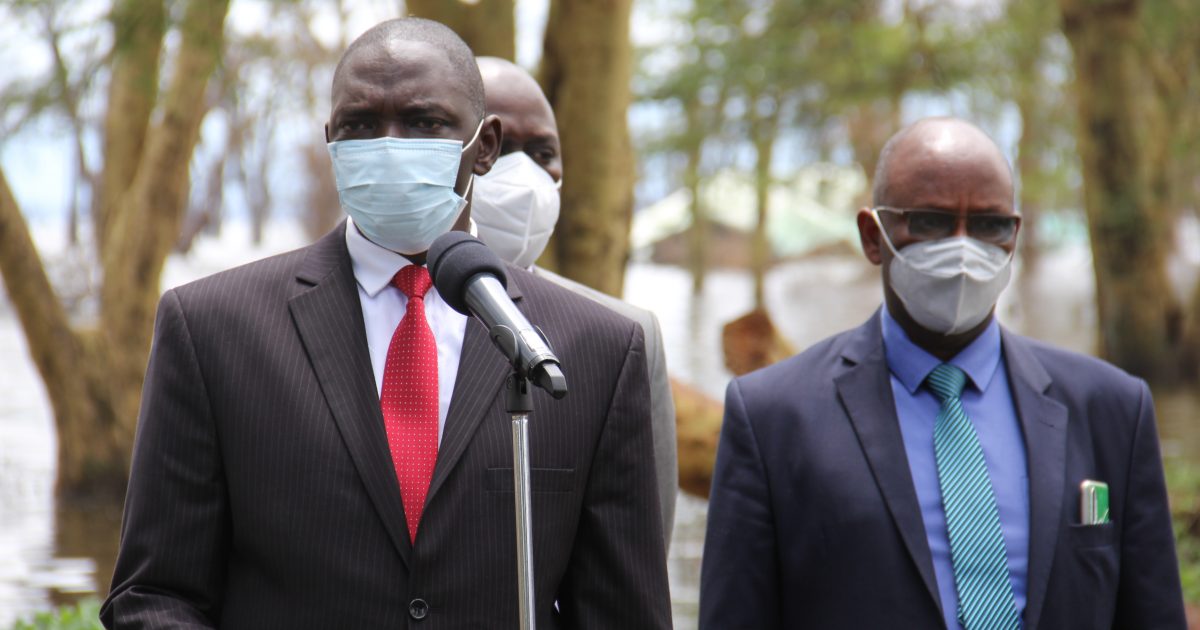Kenya Wildlife Service has reported that Lake Nakuru National Park is now accessible through Lanet and Nderit gates after the main entry was fully submerged in water.
Senior Warden Collins Ochieng said that a misleading impression had been created that the world famous bird and wildlife sanctuary had been closed down after Lake Nakuru’s water volumes swelled and destroyed several buildings and roads in the park.
“The number of visitors has increased especially after flamingoes which started flying away in 2014 before leaving the park in 2018 started flocking back. Despite rising water levels, algae that flamingos feed on have grown on the new shores,” stated Mr Ochieng.
He spoke at the KWS offices within the park over the weekend after holding talks with Government Spokesman Colonel (Rtd) Cyrus Oguna, County Commissioner Erastus Mbui Mwenda and Deputy Governor Dr Eric Korir on the impact of increased water volumes on the Lake’s ecosystem.
The senior warden said the Kenya Wildlife Service had spent Sh38 million in repairing infrastructure at the park towards improving tourism at the facility. “We have been constructing new roads and moving offices that had been drowned by the lake. The management has also reduced entry charges for domestic and international tourists. This is expected to attract more visitors at a time the world is battling the Covid-19 pandemic,” he added.
He said since flamingos are the main selling point for the park, it became a challenge to convince visitors to come without having to see the birds.
“Some visitors would reschedule their trips on learning that all the flamingoes had migrated. The massive migration hit hard the tourism, hospitality and other related enterprises in Nakuru, Naivasha, Elementaita and other neighbouring regions.
In addition to the flamingos, more than 450 bird species are found at the lake, earning it the title “a bird watchers’ paradise,” explained Mr Ochieng.
Apart from the birds, Lake Nakuru National Park plays host to four of the big five- lions, rhinos, buffaloes and leopards alongside several species of giraffe. It has other attractive points like the Makalia Falls and the Baboon Cliff.

“We hope to recover, especially after the government opened the country’s airspace. There is optimism that visitors from abroad will begin flocking to the park,” he said.
Col. Oguna exuded confidence that the number of local and foreign tourists would increase.
The Government Spokesman observed that tourism Cabinet Secretary Najib Balala in July this year halved entry fees at parks and game reserves for Kenyans in an pt to attract more local tourists.
He noted that the Tourism Ministry has issued a one-year moratorium on rents for hotels operating inside parks and other sites.
“The two initiatives will serve to boost the local hospitality capacities and sustain the tourism industry over the near term. Moreover, the Sh537 billion stimulus package announced by President Uhuru Kenyatta contains an allocation of Sh3 billion as soft loans to tourist facilities to support renovation works.
A growing number of Kenyans are also taking a keen interest in nature and wildlife. “It is refreshing to see domestic tourists spend more time enjoying and appreciating national parks and wildlife as part of their heritage,” stated Colonel (Rtd) Oguna.
Mr Mbui called on the County government to take drastic measures to curb the plastic bottle menace which are non-biodegradable and were harming animal and aquatic life.
He observed that the single use plastic waste is generated from the County’s urban centres and residential estates before being swept into lakes through storm water and rivers.
“If this continues unchecked, the lake will eventually be too toxic for the current aquatic life as well as herbivores that often come into contact with non-biodegradable material leading to their deaths.
We are delighted that Lake Nakuru is slowly reclaiming its glory as bird’s paradise,” Mr Mwenda said.
According to KWS the Lake area has increased by 20 square kilometers within the past ten years and risen from an average of 3 metres to ten meters in depth.
Kenya Wildlife Service researcher Joseph Edebe said areas that were previously grassland at the game sanctuary have now come under water. Herbivores which he noted had increased in numbers have moved to higher ground.
“The fish structure has changed from Tilapia grahami that are associated with saline water to fresh water species such as Tilapia Niloticus and Tilapia mossambicus. We also have recorded three other freshwater fish species in this Lake” stated Edebe.
The lake has swallowed up a section of the northern route at the National Park and has flooded a large part of the acacia forest to the south. The network of tracks that once scarred the lakeshore has disappeared, and the roads lead straight into the lake instead.
By Anne Mwale





